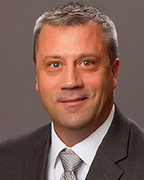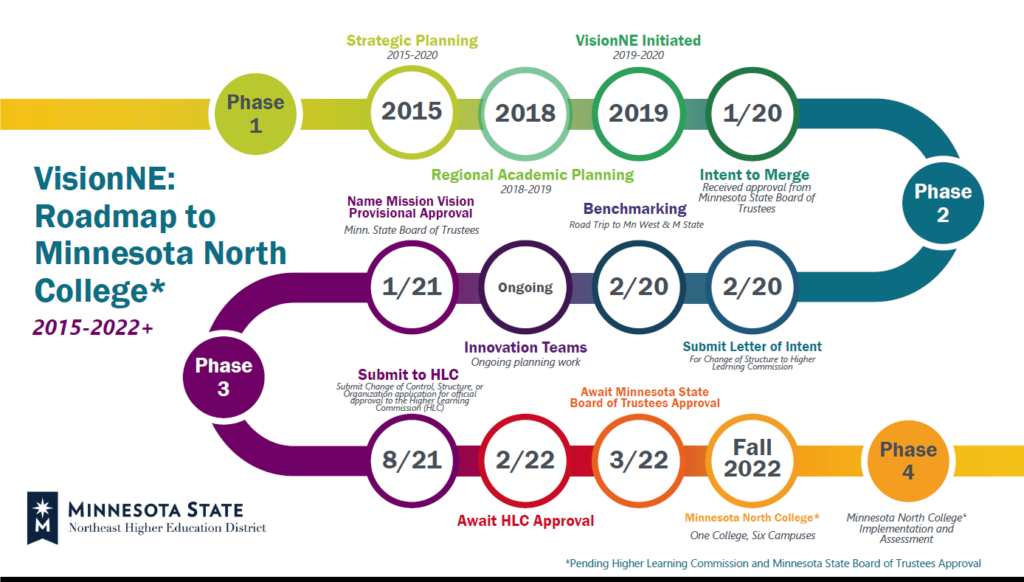In northeastern Minnesota, five separate community colleges have officially merged into one accredited college: Minnesota North College.

Since 1999, the colleges – Hibbing, Itasca, Rainy River and Vermilion community colleges and Mesabi Range College – have operated as the Northeastern Higher Education District (NHED). They were separately accredited but shared resources, such as a president and business services.
After a long planning process, called VisionNE, the merger was approved by the Higher Learning Commission (HLC) and Minnesota State Board of Trustees. President Michael Raich answered CC Daily’s questions about the rationale for the merger, the process and the lessons learned.
* * *
Prior to the merger, what challenges were the five colleges facing? What spurred the merger?
The rationale for pursuing this change of structure can be summarized in two broad categories: operational efficiency and improved services to students and other stakeholders.

The NHED colleges needed to improve operational efficiency in order to focus resources on mission-centric functions. Conducting business out of five separate student and employee databases, staffing and financing five separate accreditations, competing for student enrollment and generally duplicating efforts in areas that could be combined are all examples of practices that can be addressed in a single-college model.
Together, the NHED colleges have experienced a 35% loss of tuition-paying student FYE from fiscal years 2011 to 2020. NHED enrollment projections remain challenged in the near future as regional demographic data indicates flat population growth in our region over the next decade. The demographic challenge is made worse for our colleges because the region’s traditional college-age population is projected to decline while the population of people 65 and older will increase for the next several years. Along with less revenue due to enrollment decline, the colleges’ fiscal challenges are compounded by several years of legislatively mandated tuition freezes and biennial state appropriations that basically only cover inflationary costs.
Most importantly, services to students and stakeholders will be improved in a one-college model. Students taking courses across our campuses (instead of across colleges) will have a single transcript as well as a simplified registration and financial aid process while still benefiting from local, on-campus services. Students will have easier access to and a more robust selection of courses and career programs when we remove the silos associated with independent colleges. With one larger college, we can more clearly and consistently articulate collaborative efforts with regional K-12 and industry partners than we can as smaller, competing institutions. Overall, fiscal and human resources will better align with direct service to students in a one-college model where we are working together instead of competing.
What was the process of getting everyone on-board for the merger and for VisionNE – from college leaders to faculty and staff, to students and community members?
The five merging colleges already had a long history of collaboration. As part of the Northeast Higher Education District, the colleges already shared a president and institutional research, human resources and business services departments. This made a full merger less intimidating for most people, given the levels of cooperation and trust that were already established. Articulating clear purposes for merger, ensuring campus identities and community connections would remain, taking time to listen to all stakeholders about ideas and concerns, and engaging/empowering anyone that wanted to be involved in the merger process were all strategies that helped people get on board.
This was not a fast process. Strategic planning began in 2015. How did you keep up the momentum? What were some of the challenges along the way?
The planning process was segmented into different phases. The regional strategic planning that concluded in 2018 led to building a regional academic plan in 2019. During these planning years, merging colleges was not seriously considered as an option. That said, the resulting outcomes from both planning sessions pointed to a change of structure as a necessary step in order to achieve the desired objectives.
In the fall of 2019, we presented two different organizational structures for our students, employees and stakeholders to consider. After several months of listening sessions, it was determined that merging the five independent colleges into a singly accredited college made the most sense, and our governing board approved the intent to merge. Campus closures were not part of these decisions and all campuses remain open today. After the board approved our intent to merge, we entered a planning design phase where we built decision-making structures, innovation teams, communication strategies, accreditation teams, academic and faculty shared governance processes, etc.
Finally, we empowered all of these groups and team members to carry out the work necessary to operate as a single college. This included applying and writing a change of control application with the Higher Learning Commission.

Challenges include – but are not limited to – doing this work during the Covid-19 environment, communicating to all stakeholders in a timely manner and prioritizing the order of communications, ensuring people weren’t overworked in the process, and (this is a big one) managing the emotions tied to a sense of potential loss and uncertainty related to a major change.
What is the vision for Minnesota North College?
Mission
Minnesota North College prepares lifelong learners and engaged citizens through inclusive, transformative experiences reflecting the character and natural environment of the region.
Vision
Minnesota North College will be the premier provider of life-changing education and the catalyst for regional prosperity.
Core Values
• Access and Opportunity
• Community Engagement
• Equity and Inclusion
• Environment and Culture
• Growth and Learning
Strategic Priorities
• Increase the geographic and cultural diversity of our student body
• Improve success outcomes for all students
• Eliminate education equity gaps
• Deepen meaningful relationships with regional stakeholders and partners
• Expand programs throughout the region to meet student and community needs.
What are some lessons you learned along the way?
- Be well prepared to manage the emotions associated making a major change.
- Keep legislators and community members well informed up front and during the process.
- Build a framework for change and empower as many people as you can to be involved in creating the new model within the framework.
- Communication is complicated. Based on each communication, you need to customize the flow, determine who receives the communication, when and in what priority order. You can’t just always communicate everything broadly. Over communication can be a problem and people will stop reading/listening.
- Don’t underestimate the importance that people place on name and branding. Everyone will have an opinion so design an inclusive decision-making process that you can point to that will produce the ultimate decision.
- Identify and highlight what does not need to change. This stability brings some level of comfort for people.
- Utilize the passion, talent and knowledge of your own team/employees/students. They’ll take tremendous pride and ownership in bringing the merger to a reality.
- Articulate a clear vision of why. We called our process “Vision Northeast” (VisionNE) and focused on the compelling positive purposes for merger instead of dwelling on challenges facing higher education institutions.

